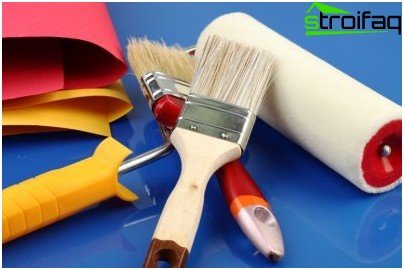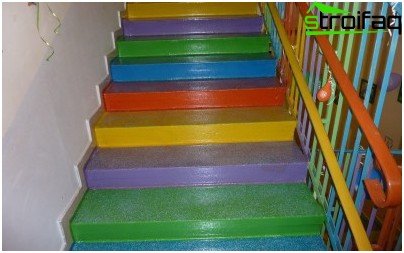How to paint a wooden staircase
Wood is one of the most versatile and sought-after building materials, but has some drawbacks, the most important of which is fragility with improper or careless processing. It is for this reason that it is important to properly and thoroughly prepare wood surfaces for painting and select high-quality coloring materials.
Content
- How to paint the stairs in the house – with paint or varnish?
- Rules and recommendations for work
How to paint the stairs in the house – with paint or varnish?
Depending on the type of wood and its quality, paint or varnish is chosen to cover wooden surfaces. The varnish will emphasize the beauty of natural material, but only if the wood for the manufacture of the stairs was taken in high quality, without defects. Since both manufacturers and customers usually think that the main characteristic of a staircase is strength and durability, the aesthetic component is relegated to the background. Sometimes an unpainted staircase can have visual flaws, so it makes sense to hide them under a layer of paint. If you want to emphasize the dignity of wood, then this point should first be agreed with the manufacturer and then the staircase, covered with varnish, will become a decoration.

The traditional way of decorating stairs without the use of bright colors and decor elements
The range of paints and varnishes is huge now and to choose the material that is optimal for your staircase is difficult, but you can, adhering to the following principles:
- if the staircase is planned to be varnished, it is better to choose semi-matt or matte. Glossy varnish in places of increased load (railings and the central part of the steps) will quickly lose its luster, and the staircase itself – appearance;
- if it is planned to change the shade of wood with wood stains before using colorless varnish, it must be remembered that some of them can noticeably darken the natural color of the wood, so it is better to coat a small area with stain and then make a decision;
- if it is decided to paint the stairs with paint, then paint based on natural drying oil is considered to be of higher quality, although paints based on synthetic drying oil are quite suitable for internal stairs.
Rules and recommendations for work
Before painting a wooden staircase, you need to accurately determine the answer to the question – will the staircase be used during painting. Ideally, it is better not to use it until the paint has completely dried, but this option is not always provided, and in such cases, professionals recommend painting the stairs through the steps. Such a cunning maneuver will allow you to not restrict movement around the house, but in this case, painting the stairs is automatically divided into two stages and the time of complete drying doubles. In addition, in this case it will be harder to apply a pattern or ornament to the surface of the steps with the help of a stencil, as sometimes it is not possible to successfully combine its elements, and people living in the house may forget that the staircase is painted and step on the still not dry steps.
Another significant detail is how to paint the stairs: disassembled or assembled. If the house is new and the staircase has not yet been mounted, then it is better to paint it before assembly, so you can easily paint over those places that will be very difficult to get to after installation.
Painting a wooden staircase will take place without complications if all the necessary materials and tools are ready in advance. You will need:
- paint, varnish or enamel, which was selected taking into account the individual characteristics of the stairs;
- brushes, rollers or spray guns, depending on what you plan to paint the stairs;
- gloves
- masking tape, due to which the painting of the wooden stairs will be done more accurately. In addition, masking tape can be used to create original patterns that will give the staircase an unusual look..

Equipment needed for painting a wooden staircase – brushes, rollers, paint sprayers
At the next stage, you should decide what color to paint the stairs. There are two main approaches to choosing a paint:
- traditional, which recommends choosing a color for the floor and stairs a few tones darker than the main color scheme of the room, trying to avoid too dark shades and gloomy colors. For a long time, brown with a wide variety of shades was considered the common color for floors and stairs..
- design, which allows you to boldly experiment with colors, shades and decor when painting and decorating stairs. It all depends on the individual preferences of the owner of the house and members of his family. Most often, original ideas for painting stairs are embodied in children’s and playrooms.

A bold approach to color experiments makes it possible to express imagination and revitalize the interior
Now you can safely begin work, keeping in mind the basic rules of how to properly paint a wooden staircase:
- It’s better to start from the top step and move down (this is not only logical and convenient, but also allows you to better control the quality of painting). It is advisable to paint from bottom to top when the exit from the room is at the upper level (for example, a staircase to the basement);
- If the paint has a thick consistency, it is better to take a round bristle brush. A flat soft brush is suitable for pre-diluted, liquid paint. To obtain a high-quality coating, you can also use a roller;
- You can paint both along and across the elements of the stairs, not forgetting that the last strokes should be applied exactly along the structure of the wood – this will provide high quality painting and an attractive appearance of the surface.
After completion of the work, it remains only to wait for the moment when the painted stairs can be used. Practice shows that to obtain a stable satisfactory result, it is better to slightly increase the drying time specified by the manufacturer, since some factors (humidity, room temperature, etc.) can negatively affect the speed at which the paint dries.






